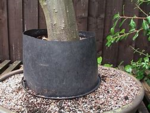tandaina
Seed
- Messages
- 4
- Reaction score
- 7
So I am a complete bonsai newbie. I'm a lifelong gardener who has always loved bonsai and assumed they were too difficult or technical. Well to heck with that. I have signed up for a day long class in September with a local bonsai nursery where we'll create a cascading Blue Atlas cedar.
But you know how this stuff goes. At my local nursery I stumbled on a red dwarf Japanese maple (Beni Hime) in among the nursery stock. (Everything else is 5' tall. These adorable things were 12".) Anyway. I fell in love with one particular tree, loved what I saw of it. I'm newbie enough to be willing to say "well if it never really gets much bigger who cares, it's adorable." So it came home with me. I realize these are very slow growing trees and I'm fine with that.
I've just cleaned it up a bit but otherwise left it as is.
It'll stay in it's big nursery pot until spring (is that correct or should it be repotted now?).
Do you all suggest I wire it now, or should I let it just grow out and wire in the spring before it breaks bud?
I am in the Seattle area, we get winters here but generally not much at all below freezing. We'll have a long slow gentle fall, I usually have roses blooming through Thanksgiving at least. (My roses never actually lose their leaves and fuscia over winter outside on their own. Super mild.
Thanks for any advice, I look forward to learning a lot.
But you know how this stuff goes. At my local nursery I stumbled on a red dwarf Japanese maple (Beni Hime) in among the nursery stock. (Everything else is 5' tall. These adorable things were 12".) Anyway. I fell in love with one particular tree, loved what I saw of it. I'm newbie enough to be willing to say "well if it never really gets much bigger who cares, it's adorable." So it came home with me. I realize these are very slow growing trees and I'm fine with that.
I've just cleaned it up a bit but otherwise left it as is.
It'll stay in it's big nursery pot until spring (is that correct or should it be repotted now?).
Do you all suggest I wire it now, or should I let it just grow out and wire in the spring before it breaks bud?
I am in the Seattle area, we get winters here but generally not much at all below freezing. We'll have a long slow gentle fall, I usually have roses blooming through Thanksgiving at least. (My roses never actually lose their leaves and fuscia over winter outside on their own. Super mild.
Thanks for any advice, I look forward to learning a lot.



